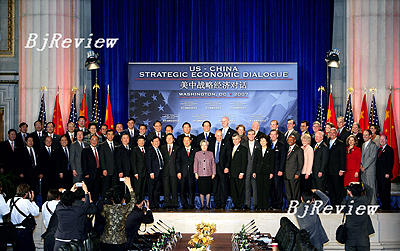
People are becoming increasingly uneasy about reports saying China is reducing its holdings of U.S. bonds. Currently, China is the second largest holder of U.S. bonds, retaining 10 percent of all tradable bonds of the United States. Some analysts fear that China's new moves to reduce this number will drag the U.S. bond market down and further weaken the dollar.
Worry first came from the U.S. Department of Treasury in June. Statistics showed by the end of April this year, China held $414 billion in U.S. bonds, $5.8 billion less than they held by the end of March. Total tradable U.S. bonds are worth around $4.4 trillion.
Analysts argue that China has continuously been increasing its holdings of U.S. bonds before this downtrend. Yet the rare move may possibly indicate a new trend towards shedding some of the excessive holdings.
The case is reminiscent of another event coming on November 25, 2004. On that day, Yu Yongding, then member of the Monetary Policy Committee under the People's Bank of China, mentioned that of all Chinese foreign reserves, dollar assets had decreased. Two days after his speech, the U.S. bond market suffered a major decrease.
Therefore, recent reports of shrinkage in holdings have caught the attention of the U.S. Department of Treasury. U.S. Treasury Secretary Henry Paulson, Chairman of the U.S. Federal Reserve Ben Bernanke, and his predecessor Alan Greenspan all recently publicly stated that the reduction of the U.S. bond holdings by foreign countries should not pose a threat to U.S. economic security. They argued that China only holds the one-day trading amount of all the U.S. government bonds combined.
As a matter of fact, China isn't currently intent on cutting its holdings of U.S. bonds.
Market forces hand
Liu Fuxiang, Professor with the University of International Business and Economics, noted that China's move is normal and is in line with market operation principles.
Liu said that the dollar has been weakening and depreciating, thus dollar assets no longer enjoy the same attraction as they used to. In order to save the country from losing money, China is smart to sell off some of the U.S. bonds.
Liu's view is echoed by Zhong Wei, financial professor with Beijing Normal University. Zhong said that Chinese foreign exchange rate reform has led to mild appreciation of the yuan against the dollar, thus reducing the necessity of dollar assets. The reason for cutting U.S. bonds is that interest rate trends in the middle- and long-term for U.S. bonds are unpredictable and uncertain. Currently, most Chinese foreign reserves are dollar assets. If the dollar depreciates greatly, China will suffer huge losses.
In fact, China is not alone. British and Russian central banks have shown similar concern.
Statistics from the U.S. Department of Treasury show that Britain reduced its holdings of U.S. bonds by $12.4 billion in April, the biggest cut of all countries.
In general, world investors were selling U.S. bonds in April. By the end of April, countries outside the United States held $2.17 trillion, down $28.2 billion from the end of March.
Xie Guozhong, former chief economist with Morgan Stanley China, contended that China's April move was caused by the change in expectations over yields of the U.S. bonds and because of the U.S. inflation rate.
Since 2002 the dollar has depreciated 15 percent. In April, the U.S. bond market depreciated $555 billion, forcing U.S. bond holders to sell.
Moreover, the Chinese central bank also has to trade foreign reserves to maintain the renminbi exchange rate in order to keep it floating within a reasonable range, and shedding U.S. bonds, which take the biggest share in China's foreign reserves, becomes the first choice for maintaining this level.
Optimizing foreign reserve structure
The $5.8 billion in U.S. bonds China shed are just a small sum, but it reflects a fact that the Chinese central bank is consciously optimizing its foreign reserve structure.
Currently, China's foreign reserves have surpassed $1.2 trillion, the largest number in the world. About 70 percent of these reserves are dollar assets, including high liquidity U.S. bonds, securities and corporate bonds. About 20 percent of the reserves are euro assets and the final 10 percent are made up of currency assets such as the Japanese yen and the South Korean won.
Judging by the foreign reserve structure, dollar assets make up the largest proportion. China's bulk purchase of U.S. dollar bonds provides financial support for the U.S. treasury deficit and helps maintain U.S. interest rates at relatively low levels.
| 